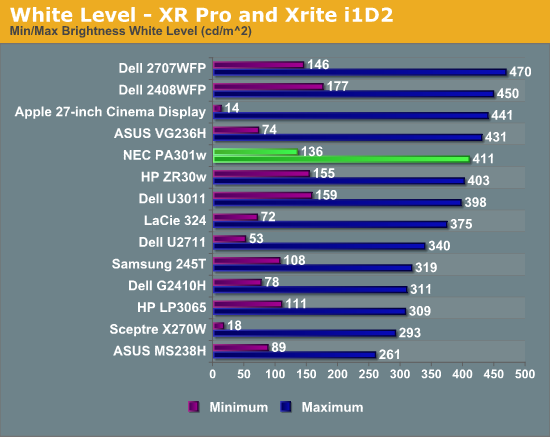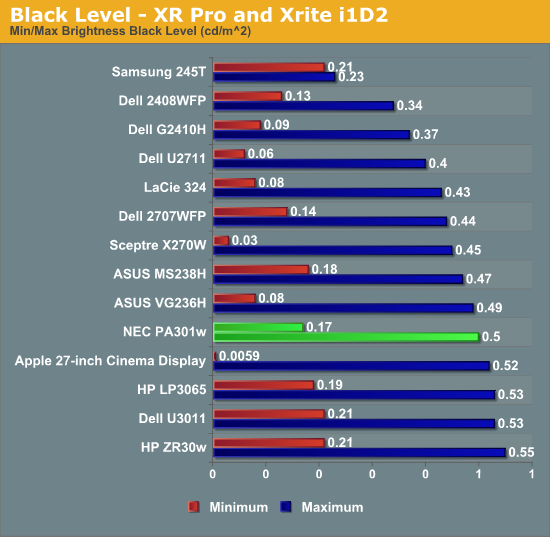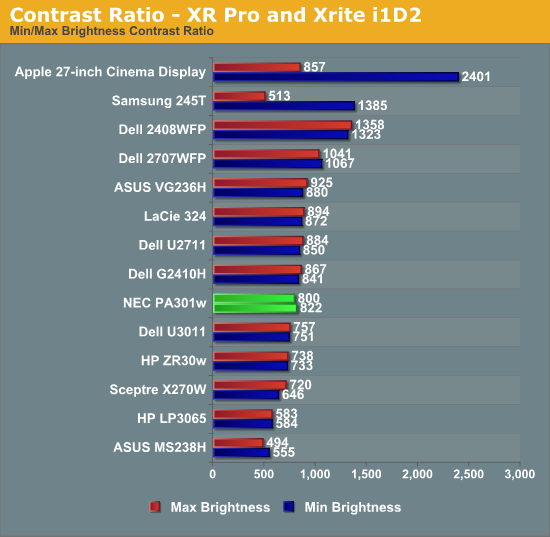NEC PA301w: The Baddest 30-inch Display Around
by Brian Klug on March 1, 2011 8:00 AM ESTBrightness and Contrast
For brightness, black level, and contrast points, we use the same colorimeter setup described earlier. Specifically, we use an Xrite i1D2 with ColorEyes Display Pro, and take measurements at maximum and minimum brightness of white and black targets. Dynamic contrast is turned off. We also let the panels settle in for a half hour at the respective settings before taking any measurements.
The PA301w uses a CCFL backlight, which makes that warm up time even more critical. The PA301w has an interesting quick warmup feature that reduces the visible brightness increase period dramatically. At power on, I measured brightness go from 160 nits (with the OSD showing 200 nits, blinking) to 210 nits in under one minute, then gradually settle to the desired 200 nits. There's a bit of overshoot, but the visual difference is hard if not impossible to actually pick out. For the sake of these tests, I waited for things to settle, but it's actually impressive how fast the PA301w can warm up to totally useable brightness levels.



Brightness settings in the OSD follow the same rules as color ones - if you select something impossible, the last changed value will show up pink, meaning it's outside of the monitor's capabilities. The same thing applies for brightness. I had no problem reaching 411 nits of brightness after getting that worked out - it's a similar thing I've seen on all other displays, sometimes you need to change contrast or color adjustment settings appropriately. Regardless, the PA301w went above the specified 350 nits of brightness, reaching 411. Contrast isn't quite the 1000:1 advertised typical, instead hovering around 800:1 pretty consistently.










92 Comments
View All Comments
mbaroud - Tuesday, March 1, 2011 - link
When i saw the title, i thought, wow, this must be a really bad monitor.After reading the review, it looks like it is THE BEST with except of weight and dimensions.
Could you please change title, its misleading.
LTG - Tuesday, March 1, 2011 - link
It's an American coloquialism instantly recognized by most who lived there whole lives here.That said, there is a lot of word play in journalism I don't get and is a little frustrating when it happens to me so I understand your point.
Mumrik - Tuesday, March 1, 2011 - link
Ever heard of "The Baddest Man of the Planet"?This is a very normal way to put it. Nothing wrong with the title.
Zoomer - Friday, March 18, 2011 - link
Given the international audience anandtech serves, he has a point.Soulkeeper - Tuesday, March 1, 2011 - link
CCFL Backlight165 watts (typical)
41.5 lbs (18.8 kg)
2560 x 1600 at 60 Hz
Might as well just get a 21" CRT with those specs and price ...
Nentor - Tuesday, March 1, 2011 - link
I am sitting in front of a 21" CRT that I am still reluctant to pass on (Sony GDM F520) and those weigh around 35 kg / 77 lbs. It can only do 2048x max.DanNeely - Tuesday, March 1, 2011 - link
We had this discussion on one of the previous 30" monitor reviews. While LEDs backlights are lower power than CCFLs and have won most of the mobile market, and while LEDs can surpass the gamut and color accuracy of midrange CCFLs at an acceptable price premium and are winning the consumer display market, the best RGB LED backlights still cannot beat the gamut and color accuracy of the best CCFL backlights. Until that happens (or until consumer demand becomes large enough to sell a less capable low power model) displays aimed directly at the professional market will continue to use CCFL backlighting despite the higher power consumption.The final point I'd make is that the "typical" power consumption NEC lists is a worst case number. Depending on brightnesss Brian measured 58-136 watts, and like most modern LCDs the maximum brightness levels are too high to use comfortably outside of an exceptionally bright area (because otherwise they'd be too dim in places), so you won't be running it at maximum brightness unless you're working outside in the desert.
Breit - Tuesday, March 1, 2011 - link
Not exactly right i guess. Every now and then there are some good RGB LED monitors in the news (at least on paper)... e.g. the LaCie 730 (http://www.lacie.com/products/product.htm?pid=1109... I don't know for sure if its any good 'cause i only have a poor Dell U3011 on my desk, but who knows?! ;)AnnonymousCoward - Tuesday, March 1, 2011 - link
I'll pass going into detail about how insane you are.Griswold - Wednesday, March 2, 2011 - link
You should have passed the test for "Professional display equipment 101" instead.